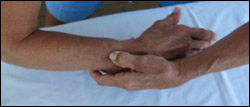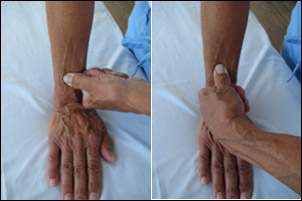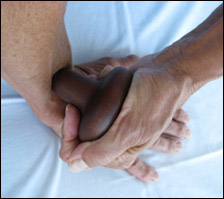Sometimes stretching isn’t enough and you need manual treatment to relieve pain in your forearm and hand. If you have hand strength, here are a few self-treatment tips that I give patients in my Neuromuscular Therapy center near Boston. More tips will be included in the following posts. This one is for the finger and wrist extensors.

Hold your right arm across your body at waist level. Wrap the fingers of your left hand around your forearm with the thumb against the outside (dorsal forearm). Press down into the soft area between the two bones, squeezing against the pressure of your fingers. Press in all along that soft space from your elbow to your wrist to find places that feel tender.
When you find a place that hurts, hold pressure there, modulating the amount of pressure so the pain is a level of 4 to 7 on a scale of 1 to 10. Hold for 8-12 seconds, or until you feel a change. (Change could mean less pain or a softening of the tissue under your pressure.) If you don’t feel a change, hold pressure for up to 20 seconds. Leaving your thumb in the same place, release the pressure to allow the blood to flow in. Press again using the same technique. If three times doesn’t produce an improvement, come back to it later. If you do feel a change, go on to the next spot, continuing to feel for tenderness.
If you feel referred pain (pain other than where you are pressing) that means you’ve found a Trigger Point. That is a very important spot to treat until the referral is gone.
 If you have no grip strength or it hurts your hand to squeeze your arm, here are two alternative positions using the thumb supported against your fist.
If you have no grip strength or it hurts your hand to squeeze your arm, here are two alternative positions using the thumb supported against your fist.
 Using a pressure tool: (Knobble, Omni Roller Ball or small ball like golf or high-bounce rubber) This is good for people with a Repetitive Stress Injury (RSI) and pain in the back of the hand or wrist or in the outer elbow. Hold the tool in your hand and press into the soft tissue or put it against a door jamb and lean against it. Find a place that hurts when you press on it and increase the pressure to a discomfort level of 4-7 on a scale of 1-10. Hold the pressure for 12-20 seconds or until you feel a change (less pain or the muscle feels softer). Continue to treat tender places using this Neuromuscular Therapy technique.
Using a pressure tool: (Knobble, Omni Roller Ball or small ball like golf or high-bounce rubber) This is good for people with a Repetitive Stress Injury (RSI) and pain in the back of the hand or wrist or in the outer elbow. Hold the tool in your hand and press into the soft tissue or put it against a door jamb and lean against it. Find a place that hurts when you press on it and increase the pressure to a discomfort level of 4-7 on a scale of 1-10. Hold the pressure for 12-20 seconds or until you feel a change (less pain or the muscle feels softer). Continue to treat tender places using this Neuromuscular Therapy technique.
For a few years now I have had forearm pain on both arms. It limits my ability to do certain repetitive actions. I made friends with a guy named Dimitri in Vermont who is a practitioner. He showed me briefly what I could do to help relieve the pain, but it was a year ago and I need a re-fresher. He told me to find the point of pain and then twist my arm and hold it there for a few seconds…is that consistent with your training and could you elaborate on it if it is accurate?! Thanks and peace to you and yours, Andrew
To stretch the wrist extensors, you must bend at the wrist rather than twist. Try closing your fist to stretch the finger extensors. For the flexors on the underside of your arm, do the opposite. Twisting helps the pronator and supinator muscles, and if you enclose your thumb in your fist, it stretches two of the thumb muscles in the dorsal side of your arm. To self-treat the muscles, find a point of pain, press and hold for up to 20 seconds, release and repeat if you don’t feel a change. Check along your forearm between the bones for other tender spots. Stretching the muscle as you self-treat increases the effectiveness of the treatment.
Hi Christina…..finally re-visited yourlves page and i am applying technique. Wow…it works!! Where can i go on the East coast to train to become a neuro-muscular therapist?? Peace and Blessings, Andrew